Or, why I built a cathode ray tube in a wine bottle.
I was leisurely reading Linus Pauling’s textbook, General Chemistry, the other day, and I found the history he threw in there with the science to be thrilling. For instance, I learned quickly that the Greek word for amber, elekton, forms the base of our word electricity, so named by William Gilbert in the late 1500s because the ancient Greeks knew that rubbing amber with wool would attract feathers and stuff. As a nuclear engineer whose job it is to make electricity, this was a fun revelation. Pauling continues to mix physical realities with the experiments used to prove them, and doing so, he quickly arrives at the cathode ray tube. After reading and thinking about it, I had another revelation. It turns out, I realized, that some large fraction of modernity, from the world order to modern health, the environment, politics, and the media passed through a cathode ray tube. Here’s how.

The Birth of the Cathode Ray Tube
In the late 1800s, a bunch of scientists were pulling vacuums on glass tubes and running high voltage across them, basically studying various aspects of neon lights. They discovered that the negative terminal (the cathode) could develop a little glow around it. As higher voltages (~10kV) and more empty vacuums (~0.01 Pa) were developed, it was found that the glow would move in one direction, so they were called cathode rays. The glass tube was then called a cathode ray tube (CRT). Using one of these, in 1897, J.J. Thompson concluded that cathode rays are a new type of negatively charged matter called an electron.
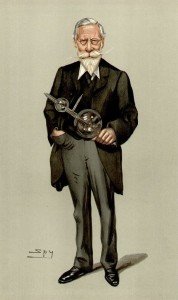
The discovery of x-rays, and the birth of modern medical diagnostics
With so much excitement with CRTs, everyone was shooting electrons around in them. In 1895, a guy named Röntgen put a thin aluminum window at the end of his CRT so the electrons could shoot out of the vacuum. He was shooting them at phosphorescent material. As he fiddled around, testing how light-tight his equipment was, he noticed that a nearby phosphorescent sample had already been exposed, even though it wasn’t in place and had opaque material in the way. He had been inadvertently producing x-rays, high energy photons that can be generated when a high-speed electron strikes certain materials. The implications were quickly understood, and soon, he had taken the world’s first x-ray radiograph of his wife’s hand. Surgery was guided by x-rays the very next year. And so a huge chain of events branches out of the CRT from here, as modern medical diagnostics.
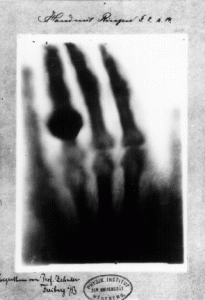
The discovery of radiation, and the path to The Bomb
Well, now everything was really going nuts in the physics world. Three weeks after Röntgen announced x-rays, a guy named Becquerel attended a talk on them and saw some x-ray radiographs. He had studied fluorescence due to sunlight before and decided to find out if sunlight hitting fluorescent materials would also emit x-rays. He used a known fluorescing material, and was surprised to see (due to uncooperative weather) that it exposed the film even without sunlight. Eventually he correctly concluded that there were rays being constantly emitted from the material itself. The material just so happened to contain uranium, a naturally radioactive substance. Marie Curie and her husband picked up the work here and isolated the radioactive parts of the mineral. Soon, Rutherford was researching how these rays get absorbed by different materials and eventually found that most of atomic mass is in a tiny center of the atom, thus discovering the nucleus and nuclear physics. From here we see that nuclear bombs, the outcome of WW2, the Cold War, many current national borders, and the predominant languages we speak have something to do with the cathode ray tube.

X-ray diffraction used to understand crystals and DNA
The phenomenon of diffraction occurs when waves bounce off a regular array of reflectors and separating into specific components. This is why CDs have rainbows in them. The way the waves diffract can tell you a lot about the array of reflectors. Visible light has a wavelength around 5500 angstroms, but x-rays have wavelengths on the order of 1-100 angstroms, which is on the same order as the distance between atoms in crystals. In 1912, a scientist named Von Laue realized that x-rays diffraction patterns could be used to discern information about crystals. This allowed people to discover things like ionic bonds and many other fundamental bits of physics and chemistry. Organic compounds were also understood through x-ray diffraction, including the discovery of the double-helix of DNA in 1952. Thus, huge pieces of modern chemistry, material science, biology, and genetics were made possible through the cathode ray tube.
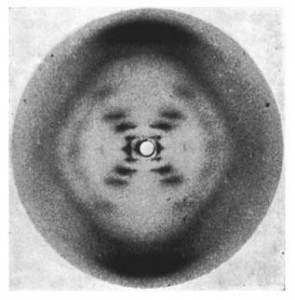
Vacuum tube amplifiers, radios, and electronics
Cathode ray tubes are evacuated glass bulbs with electricity running in them. As you can easily imagine, this led directly to vacuum tube technology. In 1906, a cathode ray tube with magnetic deflection allowing audio amplification was patented. The electronics industry thusly began. These tubes were key components in many systems, including radio, television, radar, sound recording, telephone networks, computers, and industrial process control systems. These CRT-based devices built a world of electronics, and paved the way for the incredible miniaturization of today enabled by the solid-state transistor.
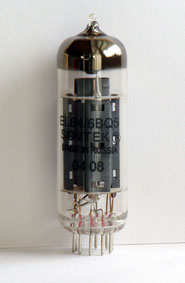
The television, modern politics and media
Most of you probably thought of big old clunky TVs when you first started reading this. A TV is simply a CRT with two focusing electromagnets that can point the electron beam up/down and left/right, rapidly passing over a phosphorescent screen that lights up when excited by the electrons. If you wiggle the beam just right, you get a moving picture known as television. The influence of the TV on the modern world can not be understated. TV has been our primary media for obtaining news, politics, entertainment, marketing, and stereotypes for decades. Televising Vietnam and other wars changed the way we fight each other. Many have spoken on the importance of all this so I’ll just leave it as given that the TV has been a huge part of the human experience.
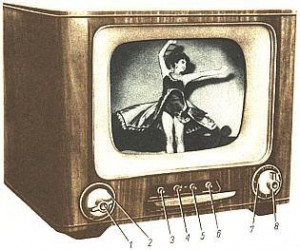
Fluorescent and neon lighting
Neon tubes are basically exactly CRTs, filled with neon gas to give that characteristic glow. Maybe these lights didn’t shift the world but they have an interesting history. And modern fluorescent bulbs are cathode ray tubes with a little trick. They have mercury vapor in them that emits an ultraviolet (invisible) glow. They put phosphors on the sides of the bulbs that convert the ultraviolet into bright white visible light familiar in all offices and supermarkets worldwide.
Building my own cathode ray tube
Wow. Such wonder. With so much history and culture passing through a single point, I just had to build one. Fortunately, it’s pretty easy to build your own CRT with consumer-grade equipment. Sure you need a vacuum pump and a high voltage power transformer, but those aren’t too hard to get. I followed instructions from here and was off and running just a few Amazon orders later.
I just got mine fired up tonight and was surprised at how beautiful it is. So much history in a wine bottle. Here’s the result:
And here are some photos of my progress.
Woo! So much fun.
Updates on the tube
The 5-minute epoxy heated up and failed my vacuum pretty quickly so I tried automotive GOOP, which wasn’t strong enough. My curved anode got messed up and I had to straighten it out. Then I settled on J.B. Weld, which really works great. I have it sealing the anode (at the bottom) and sealing the brake line to the door knob. It’s holding well. I also had the electrodes switched in my early pictures so the cathode rays were moving up, not down. Now things are more traditional. Check out this Crookes Dark Space:
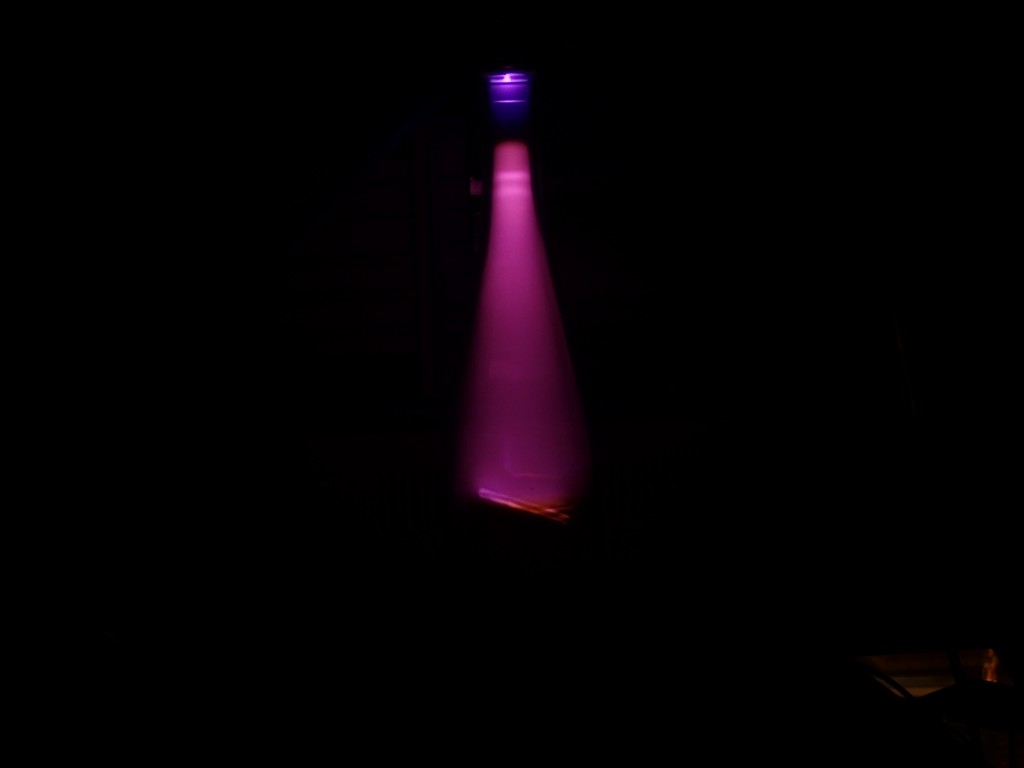
Then, if I leave the pump running for a few minutes and crank the voltage up to ~14kV or so, the Crookes Dark Space and cathode glow fill the entire tube, like this:
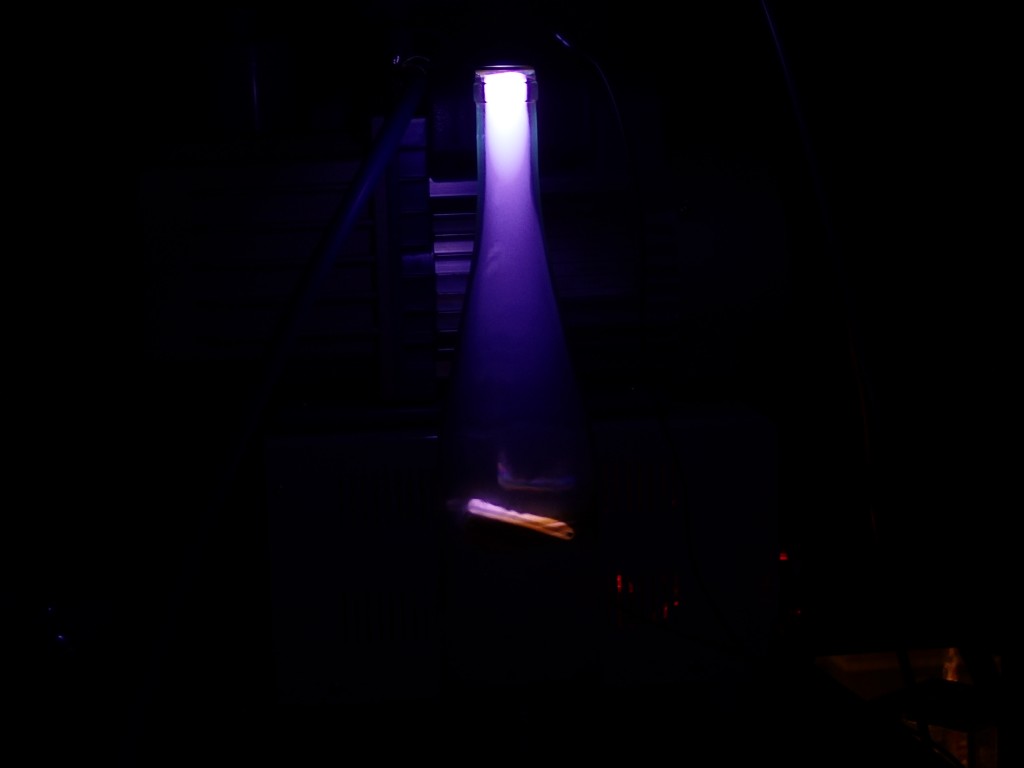
I think this means I’m getting close to 1 Pa or less. My pump is rated to 0.3 Pa but I don’t have the instrumentation to test it. Now, back in the day, Pauling notes the following:
When the pressure is somewhat less than 0.001 atm a dark space appears in the neighborhood of the cathode, and striations are observed in the rest of the tube. At still lower pressures the dark space increases in size, until at about 10-5 atm it fills the whole tube. At this pressure no light is given out by the residual gas within the tube, but the glass of the tube itself glows (fluoresces) with a faint greenish light.
I have not seen the faint green glow. I’m not sure if they used a glass back then that had a mineral in it that fluoresced green but my wine bottle isn’t fluorescing at all. I picked up some glow-in-the-dark paint recently for Tube 2.0. Maybe we’ll see something there.
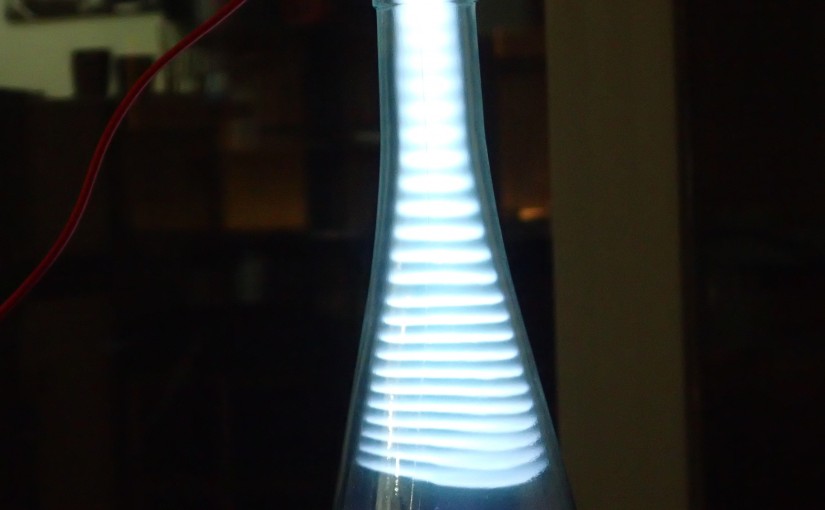
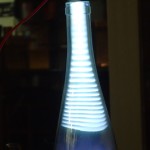
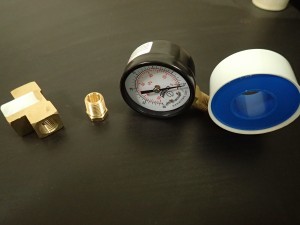
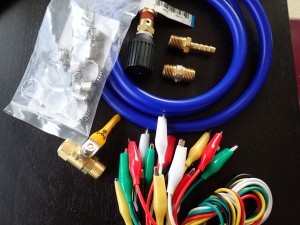
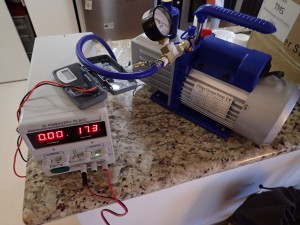

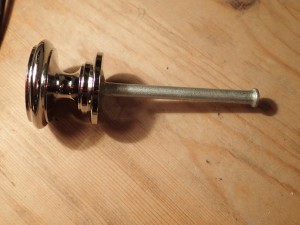
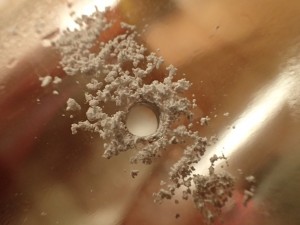
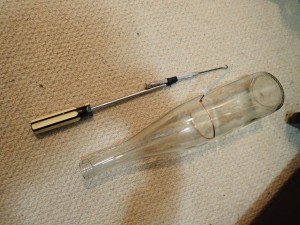

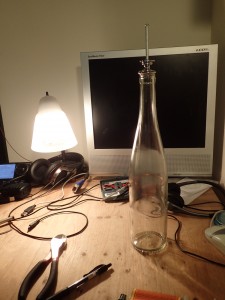
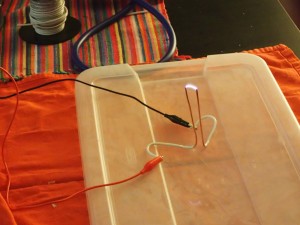
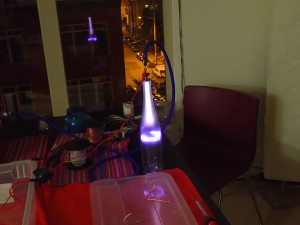
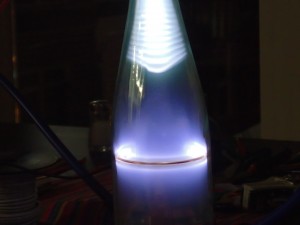
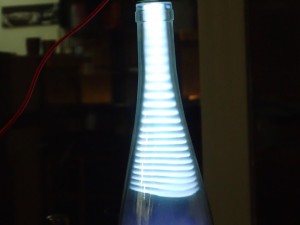
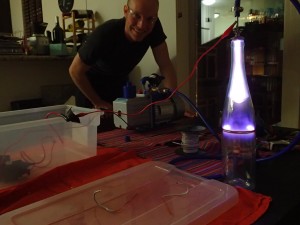
Great writeup, and an equally great build!
My son is currently building one now, and that is why I am up to speed on this right now. I don’t want to sound the panic alarm, but be mindful about hard xrays.
You probably already know this by now given the post date on this, but worst-case scenario, you could be generating some hard xrays, not just soft.
Hard xrays fall into the 5 to 10 keV range. A constant current neon sign transformer at 14 kV as you wrote, probably can only source 30mA to 60mA maximum I am guessing, so intensity would be low in any case. However, it’s the energy of the photons too that qualify them as being able to penetrate water or glass and ionize tissue.
And, in your favor, you are no where near a perfect vacuum, but nonetheless, copper anodes can throw off 8 keV to 10 keV xrays, and that is in range of the 5 to 10 keV range where hard xrays can start to be defined or created.
For comparative purposes, you are most likely accelerating the electrons to a maximum of 2.4 x the speed they would be in an old cathode ray tube. Here is a quick formula to calculate the velocity assuming a perfect vacuum (talking worst-case here), and 14 kV supply:
sqrt[ 2 * (1.6 10^-19 Coulombs) * (1.4 10^4 Volts) / (9*10^-31 kg)]
It is basically the KE formula (kinetic energy = 1/2 mv^2) made equivalent to eV, the electrons charge, e, of 1.6 * 10^-19 Coulombs times the voltage, V, and solving for v, velocity. 9*10^-31 kg is the mass of an electron.
I have been playing with neon sign transformers and HV and other oddities since the 80s. I built a meter-high Tesla coil with a 25cm sphere on top of a coil with 666 windings (we called it the Beast in commemoration of the triple six – The Omen had its influence here 😉
Keep making!
Rob
Thanks! I surveyed extensively with my fancy Geiger counter that should be sensitive to x-rays so I don’t think anything’s making it out of the glass.
Which fancy Geiger counter do you have?
My son bought the Android app RadioactivityCounter, but this is not sensitive enough I believe.
And you would need a long tube Geiger counter with a window preferably to detect the low-end of the hard xrays.
Again, I really think the inefficiencies of the bits and pieces of these builds negate all of this. It must be my age, and fatherhood creeping in. I so ignored all of this in my youth, and never owned a Geiger counter!
I was worried about it too, frankly. I used this guy which says it can detect things down to 10 keV. Below 10 keV, the attenuation length of x-rays is less than a centimeter in water and will be less in glass, so I’m confident nothing is coming out.
Very nice! What’s up with the standing waves in the ionization when running the tube in reversed polarity….any ideas?
I asked a plasma physicist about those and he wrote:
Any chance you could add a list of the items you bought off of amazon? I’m doing this same project and am having trouble finding some of the parts like the brake line.
Great job and thanks
Thanks! Looks like I lost my full list but do have the individual components still around. The vacuum hose was this guy: https://www.amazon.com/gp/product/B00TAFGSFW
What else is giving you trouble? I’ll dig up anything else you need.
wonderful content thanks for sharing this with us. – Dave